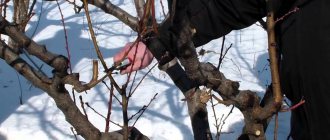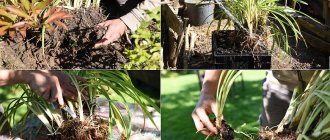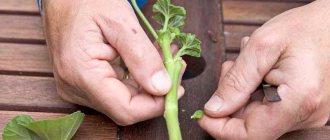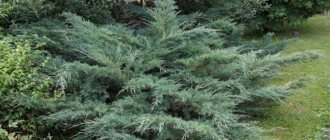How to propagate boxwood at home
Boxwood is one of the oldest plants used to decorate home gardens. It can be found literally everywhere: in parks, squares, flower beds, and near official institutions. Private plots of land were no exception. They are often used to frame flower beds and lawns. Also, unusual geometric figures and shapes are made from boxwood bushes, which “revive” the garden even in winter, since this plant is an evergreen.
Tall varieties of boxwood are usually used in the formation of hedges . All types of boxwood are characterized by slow growth and tolerate shearing well, so they are ideal for use in “garden architecture.” The word “ haircut ” is perhaps the key word in caring for boxwood. After all, in any case, no matter how you use this plant to make the bushes look neat, they simply need a haircut.
During the cutting process, a huge amount of cuttings is formed - free planting material. And if you want to plant a lot of boxwood, and you understand that buying seedlings will cost you a pretty penny, then “trimmings” are what you need. Use them as cuttings for rooting. And in just 2 months you will have enough planting material to fence your entire plot with boxwood, and even share it with your neighbors. Rooting boxwood cuttings is not difficult and can be done in 5 tips.
Features of boxwood propagation
To create a hedge, a large amount of planting material is required. It can be obtained from just one bush by propagating the plant using cuttings. When the boxwood crown is formed in the summer, many branches remain, which can be used for vegetative propagation.
In June or July, when pruning the plant, leave green cuttings about 10 cm long. Prepare a separate place for them, since the planting material will take root and grow for quite a long time. Find a shady corner of the garden. Dig up the soil, remove all weeds and add clean sand and humus.
Remove the lower leaves from the cuttings and place them in a solution with a root formation stimulator, such as Kornevin, for a day. Plant the cuttings, burying them halfway, in a prepared bed in a shady place and water generously.
Do not let the soil dry out; water the plants regularly, otherwise the green cuttings will quickly dry out. To prevent drying out, you can cover the plantings with non-woven material, but in this case you will need to ventilate the greenhouse daily.
Boxwood takes quite a long time to take root; it may take about a year for strong roots to appear. After 2-3 years, young plants can be planted in a permanent place. This can be done at any time in spring and summer, but it is advisable to have time to plant 1.5-2 months before the onset of frost so that the boxwood has time to take root.
Choose the right cutting time
Growing boxwood.
Boxwood is trimmed every four weeks during its active growth period - from April to September.
In principle, you can take boxwood cuttings at any time and successfully root . But keep in mind that you will not be able to plant cuttings taken from August to September in the ground this year. They simply won’t have time to take root and will most likely die in the winter. Although a conscientious owner has remedies against winter. They can be insulated , or you can keep the container with rooted cuttings in a cool place with a positive temperature and plenty of light (not outside).
In general, there will be more trouble. April and May branches of boxwood can also be rooted, but many of them will die, because... the growing season has just begun, and the shoots have not ripened. It is best to take boxwood trimmings in June - July. Rooted seedlings planted in open ground manage to take root and easily endure the winter.
Transfer
How to replant boxwood in the fall? Adult boxwood tolerates transplantation well at any age, and the favorable time for transplantation is considered to be from July to November .
Immediately after transplanting boxwood in the fall, the plant needs increased watering.
To stimulate growth , it is recommended to replant boxwood once every 3-4 years until the bush becomes large enough.
Transplantation of an adult plant is carried out in the same way as the initial planting in open ground, that is, together with a lump of earth. After replanting, in the area of the root circle it is necessary to mulch with pine bark.
Prepare cuttings correctly
-ripened but not yet lignified shoots are suitable for rooting The cuttings are cut from 10 to 15 cm in length. The lower end of the cutting should be cut not with pruning shears, but with a sharp garden knife at an angle. Pruning at an angle increases the surface area where roots will form. Additionally, in the lower part of the cutting, you can make grooves by cutting the bark lengthwise.
Then the cuttings are exposed; to do this, all the leaves are cut off, leaving 2-3 at the very top. This procedure will reduce the evaporation of moisture, because the cuttings do not yet have roots, and very little moisture reaches the leaves. To be sure, the lower part of the cutting can be soaked in a solution or powdered with a root formation stimulator (kornevin, heteroauxin, etc.). But this is not necessary.
Boxwood cuttings and rooting
The optimal time for boxwood cuttings is June-July. It is during this period that shrubs are trimmed. Young plants obtained from cuttings have time to take root thoroughly and, as a rule, overwinter well with little shelter. From the cut boxwood shoots, you can select shoots suitable for cuttings. They should be well ripened, but not yet lignified.
The cuttings should be cut 10-13 cm long. The tool should be disinfected (hold over the fire and cool or treat with alcohol). It is better to use a well-sharpened knife for this; the pruning shears compress the tissue, making rooting of cuttings difficult. The lower cut must be made obliquely under the bud. It is not advisable to touch the cut area with your hands. The lower leaves from the cuttings must be removed (it is better to cut them off), leaving no more than 7 pieces at the top.
It is better to root boxwood cuttings in a mixture of leaf or turf soil and sand. The place should be chosen in partial shade. To avoid damaging the young roots when replanting, you can press scraps of plastic bottles without a bottom (cylinders 10-12 cm high) into the soil, leaving the top 1-2 cm above the soil surface.
Before planting, it is advisable to treat the lower part of the prepared cuttings with a root formation stimulator (place in a Heteroauxin solution for 4-6 hours or dust with Kornevin). When planting, the entire part of the cutting, cleared of leaves, should be buried. You need to make a hole in the soil (for example, with a pencil or stick), insert a cutting and squeeze the soil around it so that there are no voids, and water it. To maintain high air humidity, rooted cuttings should be covered with jars, and if there are a large number, install arcs and stretch the film.
Care involves regular watering and removing weeds at an early stage. In about a month, the cuttings will begin to form roots, and after 2 months they can be transplanted to a permanent place. If scraps of plastic bottles were used, then the transplantation is painless; the cylinder is removed through the top.
Prepare soil mixture for rooting
Any containers (pots, boxes, cut plastic bottles, etc.) are suitable as containers for rooting. The depth of the container should be such that the entire part of the cutting, cleared of leaves, can fit into it. As a rooting substrate, prepare a mixture of turf or leaf soil half and half with sand. The mixture should be light, “airy”, and it should be easy for roots to germinate .
In the bottom of the container, be sure to make several holes to drain excess water . Simply stick the cuttings into the soil mixture, leaving a small (2-3 cm) part with leaves on the surface. Moisturize thoroughly. Be careful here - don’t water, just moisten.
The substrate should be moist, but not “swampy”. In general, it is ideal for this to place wicks (twisted cotton fabric, thick ropes, etc.) under the soil mixture. Place the ends of the wicks in jars of water. Then “watering” will occur automatically and in the required quantities. To reduce water evaporation , you need to create 100% humidity. To do this, cover the cuttings with a jar, plastic bag or glass.
When is it time to plant boxwood cuttings?
Cuttings take root within several months. Some are faster, while others are slower. It depends on many factors. And identical cuttings located in the same conditions may have different root systems.
Plants ready for transplantation, as a rule, form not only roots, but also new light green shoots.
There is no need to shake the roots off the ground, as shown in the picture. This is done only so that you can see the difference in the size of the root system between cuttings that are identical at first glance. Transplant the cuttings together with a lump of earth - then they will better take root in the new place.
If you still have questions about growing this attractive shrub, take a look at our article What to Know When Growing Boxwood.
Provide cuttings with proper care
Strictly speaking, all care comes down to maintaining the required soil moisture. To do this, spray with water 2-3 times a day. Your greenhouse needs to be ventilated periodically. It is very important that the plants should not come into contact with their parts either with each other or with the shelter.
Otherwise, due to increased humidity, rot will begin to develop at the point of contact and the cutting will die. If found, carefully trim the rotting area with scissors (usually this is part of the leaf). After about 2 weeks, the cuttings will begin to sprout roots. After 30-40 days, the cuttings take root, then you can open the greenhouse slightly and water as needed.
Methods and timing of reproduction
There are 4 ways to propagate evergreen boxwood:
- cuttings;
- division;
- seeds;
- layering.
Depending on the method, the optimal time frame for carrying out the work is selected. Boxwood can be propagated by cuttings and layering throughout the summer. Several young bushes are produced per season.
Seeds are planted in October. In winter they germinate, and in the spring ready-made seedlings are obtained. It is better to divide the bush in the first half of autumn. If you do this in summer in hot weather, there is a risk that the plants will not take root.
Related article:
The most unpretentious conifers for the garden: TOP 7 varieties of juniper that will decorate any area
When working with boxwood, you need to wear gloves and protective clothing. All parts of the plant contain more than 7 dozen alkaloids, many of which are deadly.
Correctly plant rooted cuttings in a permanent place
When to plant boxwood?
About 2 months after the start of rooting, boxwood seedlings form a fully developed root system and can be planted in the ground in a permanent place.
If cuttings were carried out in June - July, then by the beginning of cold weather the seedlings have time to take root well in a permanent place.
Boxwood grows best in fertile soils, but it also tolerates poor soils. Mature compost must be added to poor sandy soil . The soil should be permeable and moist, without stagnant water. Boxwood is not picky about lighting. It tolerates both sun and shade well.
After replanting, do not fertilize the plant for a month, but water it regularly. The soil under the young seedling should not dry out. Since planting in the ground will most likely take place in the fall, given the unpredictability of our winters, care must be taken to protect young plants. To do this, the soil under the plants is mulched with fallen leaves, peat, and compost. In severe frosts, boxwood seedlings must be covered with agrofibre or at least burlap.
In order not to break the still thin seedlings, it is necessary to build a frame over them from cut tree branches or other available material. Spruce branches - cut branches of coniferous trees - will be a good insulation material. In addition to the fact that it will retain heat, it will also successfully retain snow on your plantation, and snow, as you know, is the best insulation for plants. In harsh winters, adult plants also have to be protected.
Main features of an evergreen plant
Boxwood has become popular for a very long time and even with the advent of many new varieties of similar plants, it is often used for landscaping. This feature is due to the slow growth of the plant, which allows haircuts to be carried out quite rarely. In addition, annual pruning provides an incentive to grow even more foliage.
Boxwood is an evergreen shrub, and this feature is also an advantage in garden design. The plant is native to the Mediterranean and East Asia.
Interesting! Boxwood is used not only to decorate garden areas and park areas. It makes interesting bonsai trees. This bush grows well in small containers at home.
Boxwood is one of those plants that easily tolerate a lack of light. When choosing a place to plant in the garden, you can safely give preference to shaded areas.
Boxwood cuttings at home
Boxwood is a fairly unpretentious crop, by purchasing which you can always get several additional specimens through propagation. Thanks to this, without extra financial costs, you can create a hedge and divide the garden into zones.
Boxwood can be propagated not only by cuttings; seed propagation is available for this, but the first option is more preferable.
For cuttings you need to follow some rules:
- cuttings should be taken from a healthy and young shoot;
- for planting you will need light and well-drained soil;
- seedlings must be maintained in favorable conditions;
- For care, it is important to create humidity and a suitable temperature regime.
All these rules will contribute to the rapid rooting and creation of high-quality samples of evergreen boxwood.
Time to prepare cuttings
Summer pruning is the optimal time to prepare cuttings. This way you won’t have to additionally cut off the material and disrupt the design of the crown. But if time is lost, you can always collect several cuttings at any time of the year.
Important! It is better not to harvest cuttings in April and until the end of June. It is at this time that the plant is actively growing and the shoots are still very young and tender. If such material is to be propagated, it must be well shaded and treated with more care.
The rest of the time, planted cuttings can adapt without unnecessary intervention.
Reproduction is often carried out by cuttings from apical shoots. They have a high speed of adaptation and formation of a strong root system. The lower cut is made next to the living bud at an angle, so that the plane for root formation is larger. The cut is made with a sharp tool to leave a smooth surface. You can also make several notches along the bark up to 1 cm in height.
Boxwood propagation in spring
You can propagate boxwood at this time of year in open ground. To do this, parts of the shoots are cut and the side that will go deeper into the soil is treated with a growth stimulator.
Evergreen boxwood is placed in a lighted area with prepared nutrient soil. To create a suitable microclimate, the cuttings are covered with cut bottles or glass jars. A similar procedure can also be successfully carried out at home.
Interesting! In order for rooting to occur as quickly as possible, soil moisture must be constantly maintained. In addition to watering, shading from direct sun is also practiced, which can dry out the soil.
In the evenings, the cover can be removed briefly for ventilation and the cuttings can be sprayed with settled water.
By the end of the summer, the bushes will get stronger, their root system will form and in the fall they can be transplanted to a permanent place. The replanting is completed by mulching the tree trunk circle, and for the winter the plant is hidden from frost under burlap or agrofibre.
Rooting boxwood cuttings in autumn
In early September, boxwood also reproduces well. In this case, the cuttings are prepared with the arrival of autumn so that the cuttings on the bush can be tightened before the onset of frost.
The cuttings are cut about 15 cm in length, and each of them should have several active buds. Planting is carried out in prepared soil up to the first leaf, after which the seedlings are covered to create a greenhouse effect.
Seedlings that have already taken root and have leaves appear on them must be planted in separate pots without destroying the earthen ball. It is better to place the pots in a warm place with artificial lighting. At home, throughout the entire period they need to be watered, sprayed and fed every 10 days.
With the arrival of early spring, the cuttings need to be hardened, for which they are taken out onto the street or balcony, increasing the time spent in the fresh air every day.
Important! Boxwood is an unpretentious evergreen bush, and the survival rate of its cuttings is 90%. It will be possible to plant seedlings immediately after the end of frost and the soil warming up to + 100C.
Winter propagation of boxwood
Those who have a greenhouse on their territory can propagate boxwood even in winter. To do this, cuttings are collected at the end of autumn, about a couple of weeks before the expected frost.
The greenhouse is organized in an area with dug up soil, where peat and leaf soil are poured on top. After leveling the surface and light compaction, a couple of centimeters of river sand are poured. The result should be light and well-drained soil.
Cuttings for winter propagation are taken from 2-year-old shoots, the leaves are removed, and the cut is dipped in a growth stimulator. The cuttings are planted at a distance from each other, after which they are regularly watered.
All winter you need to monitor the condition of the cuttings. By the time spring arrives, they will have taken root and can be planted in a permanent location. For faster adaptation, at first it is better to cover the seedlings from direct sunlight and drafts. In the future, it is enough to water the bush, feed it, and free the soil around it from weeds.
Interesting! When rooting cuttings at home, roots can also be obtained in water. To do this, the leaves are removed from the shoot and it is placed in a container with 1/3 or a little less water. After the roots appear, the cuttings are planted in pots and grown until the weather warms up.
Boxwood care
- It is best to grow boxwood on clay soils that contain lime. If you have sandy soil, then add mature compost to it.
- Water the plant so that the soil is always moist . Boxwood tolerates shade and partial shade well. The worst growth is in direct sunlight. Therefore, it is worth watering boxwood abundantly in the summer, as it can die from lack of moisture.
- Boxwood pruning should be done with mechanical scissors with sharp blades. After each haircut, do not forget to water the bushes well and feed them with fertilizers for restoration and growth.
- In the fall, before the onset of frost, it is recommended to water boxwood abundantly, as if saturating the plants with moisture for a very long winter period. It is advisable to cover the soil under the bushes with peat.
- Proper planting and care of this plant will help accelerate the growth of the crop, and in 3-4 years you can begin to form it into a hedge, border or balls.
Boxwood: description of the plant
Boxwood belongs to the genus of slow-growing evergreen shrubs and trees of the Boxwood family. In nature, according to the latest updated data, there are about one hundred species of this plant. They grow naturally in East Asia, the Mediterranean countries, and the West Indies. The Latin name Buxus was given to the plant by the Greeks.
There are three large areas of boxwood in the world - Central American, Euro-Asian and African. In culture, the boxwood tree is considered one of the oldest ornamental plants, which is grown as a garden and potted crop. In warm regions, shrubs are used not only as borders and hedges. Picturesquely trimmed boxwood bushes decorate lawns and gardens.
At home, boxwood is very popular for bonsai, as the plant grows well in a small container, actively bushes, has small leaves and tolerates pruning well. Boxwood can be grown in containers. In this case, very cute balls are formed from the bushes.
However, as we have already said, this plant grows very slowly. The annual growth of shoots is only a few centimeters, so admirers of this beautiful plant purchase several seedlings at once. You can also save a little money by propagating boxwood by cuttings. How to do it? Where to begin?
There are two ways to propagate boxwood: by cuttings in water and in the ground. The first method is long and less effective, since shoots often rot in water. The second method is very popular, so we will talk about it in more detail.
How to propagate by layering and dividing the bush?
This method is considered by many to be the easiest. An undoubted advantage is that the procedure is not tied to a specific time; it can be carried out from spring to autumn. You can use bushes that are older than two years. The external branch is selected on them. It should be located near the ground. After this, a trench of 15 centimeters is dug. The branch is attached to the ground with pins. Wire or pegs forked like a slingshot are also suitable. To allow the root system to develop, all leaves are removed from the branch and the bark is slightly cut.
The branch fixed in the trench must be sprinkled with a soil mixture made with the addition of turf soil, humus and peat. After this, you need to make sure that the soil does not dry out. Watering is carried out regularly. When the first shoots appear, a small shelter is made to protect them from the scorching sun.
Another way is division. This may be a necessary measure, because the bushes will eventually fill the space allocated for them, even if pruning is constantly carried out. This threatens with a lack of nutrition and light, and accordingly, decorative properties suffer.
The transplant, as in the previous case, is not tied to time.
Where the boxwood will separate from the bush, the earth is dug up. A section of the root that has healthy shoots is carefully cut off with a knife or shovel, and then placed vertically in a previously prepared planting hole. It is necessary to ensure that the soil is moist. It is gradually compacted.
As for watering and fertilizing, this should be done regularly. Seedlings require the same nutrition as adult bushes. After transplantation, you need to create artificial partial shade for at least a few days - this will protect the plant and allow it to adapt more quickly to new conditions. Even novice gardeners can grow boxwood using similar methods.
Growing from seeds
This procedure is performed quite rarely, as it has a number of difficulties. Growing from seeds requires a lot of time, as well as significant effort from the gardener. First of all, you need to take care of collecting seeds. The bush is pruned quite often, and therefore the seed does not have time to ripen. Accordingly, gardeners have to leave several branches without cutting them.
The collection of seed material is carried out in the fall.
The seeds of the bush are quite strong and do not germinate well. A year after collection, they are no longer suitable for propagation, so when purchasing seeds in a store, you should pay close attention to the collection date so as not to waste time.
When can you transplant a plant into the garden?
If the cuttings were prepared and placed for rooting in spring or summer, then by autumn they will be strong enough to survive frosts. Such plants can be carefully transplanted into the ground in early autumn.
Experienced gardeners practice rooting spring and summer cuttings in open ground beds so that they do not require replanting in the fall.
Spring and summer cuttings can also be left in pots to grow indoors. In this case, they are transplanted into the ground in the spring.
Cuttings cut in September will not be able to take root well by winter, so they are always planted only in pots.
With the onset of cold weather, they are taken into the house and grown during the winter, like indoor plants.
By spring, such specimens will grow well and become stronger. With the onset of spring warmth, they are planted in flower beds or in the garden.
Preparing containers
First of all, prepare containers in which the shoots will take root. Flower pots or small plastic buckets, compact but at the same time deep, are suitable for this. You will need a soil mixture for planting: light fertile soil and sand in equal parts. Rooting of cuttings is carried out without drainage.
Fill the selected containers with soil, compact it a little and make small depressions. You can plant five cuttings at once in a medium-sized pot (about twenty centimeters), evenly distributing them in a circle, closer to the sides.
How long does it take for cuttings to root?
The process is quite lengthy. Cuttings take several months to take root. Some are faster, others are slower. This is due to many factors. Identical cuttings that are in the same conditions may have different root systems. Plants ready for transplanting usually develop not only roots, but also young light green shoots.
As you can see, propagating boxwood by cuttings is not at all difficult, especially if it is possible to cut shoots from a three-year-old bush. And the result of your work will certainly please you and your loved ones.
Boxwood is a beloved evergreen plant with small leathery leaves, which has long been used in landscape design and for interior decoration.
Nowadays you won’t surprise anyone with a flowerbed with dahlias or petunias. Today it is customary to decorate city streets and adjacent areas with special care and subtle artistic taste, using perennial plants for this purpose. Living green hedges, arches, gazebos, tunnels under overhanging foliage help residents of big cities again and again feel the beauty of nature and not lose touch with it. The art of topiary, known back in Ancient Rome - the creation of living green sculptures from plants - has become widely popular these days.
From those ancient times to the present day, boxwood was considered one of the best plants for creating such garden forms. It grows so slowly that 2-3 trims per season are enough to keep topiaries and hedges in good shape. In addition, boxwood is very plastic. This means its ability to respond to pruning by growing new branches, which only makes its crown thicker and denser.
Large green sculptures are formed from several plants planted close to each other. Hedges and labyrinths are obtained by planting a huge number of boxwood seedlings in a certain pattern. And here a logical question immediately arises: where to get such a number of seedlings? How to propagate boxwood?











